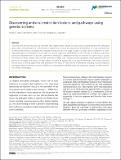Files in this item
Discovering antiviral restriction factors and pathways using genetic screens
Item metadata
| dc.contributor.author | Jones, Chloe E. | |
| dc.contributor.author | Tan, Wenfang Spring | |
| dc.contributor.author | Grey, Finn | |
| dc.contributor.author | Hughes, David John | |
| dc.date.accessioned | 2021-05-31T09:30:02Z | |
| dc.date.available | 2021-05-31T09:30:02Z | |
| dc.date.issued | 2021-05-21 | |
| dc.identifier | 274387465 | |
| dc.identifier | dd1a426b-08ff-4a0c-b715-482619cc01d1 | |
| dc.identifier | 34020727 | |
| dc.identifier | 85106737507 | |
| dc.identifier | 000659946800008 | |
| dc.identifier.citation | Jones , C E , Tan , W S , Grey , F & Hughes , D J 2021 , ' Discovering antiviral restriction factors and pathways using genetic screens ' , Journal of General Virology , vol. 102 , no. 5 , 0001603 . https://doi.org/10.1099/jgv.0.001603 | en |
| dc.identifier.issn | 0022-1317 | |
| dc.identifier.uri | https://hdl.handle.net/10023/23279 | |
| dc.description | Research in the Hughes lab is supported by a grant from the Academy of Medical Sciences (SFB003/1028), a grant from Tenovus Scotland (T20/63), and The Wellcome Trust Institutional Strategic Support Fund (ISSF). Research in the Gray lab is supported Medical Research Council (MR/N001796/1) and the Biotechnology and Biological Sciences Research Council (BBS/E/D/20002172). C. E. J. is supported by a University of St Andrews Ph.D. scholarship. | en |
| dc.description.abstract | Viral infections activate the powerful interferon (IFN) response that induces the expression of several hundred IFN stimulated genes (ISGs). The principal role of this extensive response is to create an unfavourable environment for virus replication and to limit spread; however, untangling the biological consequences of this large response is complicated. In addition to a seemingly high degree of redundancy, several ISGs are usually required in combination to limit infection as individual ISGs often have low to moderate antiviral activity. Furthermore, what ISG or combination of ISGs are antiviral for a given virus is usually not known. For these reasons, and that the function(s) of many ISGs remains unexplored, genome-wide approaches are well placed to investigate what aspects of this response results in an appropriate, virus-specific phenotype. This review discusses the advances screening approaches have provided for the study of host defence mechanisms, including CRISPR/Cas9, ISG expression libraries and RNAi technologies. | |
| dc.format.extent | 15 | |
| dc.format.extent | 1612046 | |
| dc.language.iso | eng | |
| dc.relation.ispartof | Journal of General Virology | en |
| dc.subject | Innate immunity | en |
| dc.subject | CRISPR–Cas9 | en |
| dc.subject | Genome-wide screens | en |
| dc.subject | RNAi | en |
| dc.subject | Antiviral immunity | en |
| dc.subject | Interferon | en |
| dc.subject | QR355 Virology | en |
| dc.subject.lcc | QR355 | en |
| dc.title | Discovering antiviral restriction factors and pathways using genetic screens | en |
| dc.type | Journal item | en |
| dc.contributor.sponsor | The Wellcome Trust | en |
| dc.contributor.sponsor | Tenovus-Scotland | en |
| dc.contributor.institution | University of St Andrews. School of Biology | en |
| dc.contributor.institution | University of St Andrews. Biomedical Sciences Research Complex | en |
| dc.identifier.doi | 10.1099/jgv.0.001603 | |
| dc.description.status | Peer reviewed | en |
| dc.identifier.grantnumber | en | |
| dc.identifier.grantnumber | en |
This item appears in the following Collection(s)
Items in the St Andrews Research Repository are protected by copyright, with all rights reserved, unless otherwise indicated.

